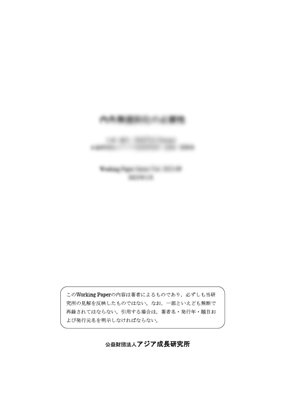A Gravity Model Analysis of Korea's Trade Patterns and the Effects of a Regional Trading Arrangement

| 執筆者 | Chan-Hyun Sohn |
|---|---|
| 発行年月 | 2001年 4月 |
| No. | 2001-09 |
| ダウンロード | 484KB |
内容紹介
The purpose of this paper is to empirically analyze Korea's trade patterns based on the gravity model and to suggest possible ways to expand trade by identifying important factors determining Korea's bilateral trade flows. The gravity model assumes that trade flows between two countries are positively related to their economic size and negatively related to the distance between them. By taking into account geographical factors, such as distance, population and adjacency, which had long been disregarded by international trade theorists, the gravity model is now recognized as one of the best models for explaining international trade volumes.
In this paper, new explanatory variables, such as the Trade Conformity Index and APEC membership, were also included in order to examine the peculiarity of Korea's trade patterns - whether they follow the Heckscher-Ohlin model or the Differentiated Product model - and to estimate the influence of a regional economic bloc on Korean bilateral trade flows.
According to the regression results of the analysis, it was found that Korea's bilateral trade patterns fit the basic gravity model well and that inter-industry trade, as explained by the Heckscher-Ohlin model, is prevalent in Korea's international trade. Therefore, in order to expand bilateral trade volumes, it appears to be more desirable for Korea to promote bilateral trade with countries in close proximity and having large economies. However, Korea's actual trade volumes with countries like Japan and China which, in terms of economic size and distance, present greater advantages, seem to fall short of the trade volumes predicted by the gravity model. This implies that there are significant trade barriers between Korea and these countries. Therefore, by promoting a deeper form of trade liberalization with both Japan and China, Korea is expected to fully exploit its trade potentials and maximize the gains from trade.
